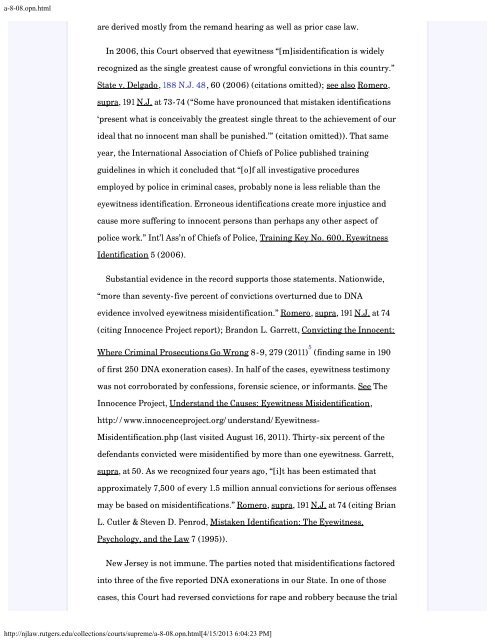State v. Henderson and the New Model Jury Charges - New Jersey ...
State v. Henderson and the New Model Jury Charges - New Jersey ...
State v. Henderson and the New Model Jury Charges - New Jersey ...
Create successful ePaper yourself
Turn your PDF publications into a flip-book with our unique Google optimized e-Paper software.
a-8-08.opn.html<br />
are derived mostly from <strong>the</strong> rem<strong>and</strong> hearing as well as prior case law.<br />
In 2006, this Court observed that eyewitness “[m]isidentification is widely<br />
recognized as <strong>the</strong> single greatest cause of wrongful convictions in this country.”<br />
<strong>State</strong> v. Delgado, 188 N.J. 48, 60 (2006) (citations omitted); see also Romero,<br />
supra, 191 N.J. at 73-74 (“Some have pronounced that mistaken identifications<br />
‘present what is conceivably <strong>the</strong> greatest single threat to <strong>the</strong> achievement of our<br />
ideal that no innocent man shall be punished.’” (citation omitted)). That same<br />
year, <strong>the</strong> International Association of Chiefs of Police published training<br />
guidelines in which it concluded that “[o]f all investigative procedures<br />
employed by police in criminal cases, probably none is less reliable than <strong>the</strong><br />
eyewitness identification. Erroneous identifications create more injustice <strong>and</strong><br />
cause more suffering to innocent persons than perhaps any o<strong>the</strong>r aspect of<br />
police work.” Int’l Ass’n of Chiefs of Police, Training Key No. 600, Eyewitness<br />
Identification 5 (2006).<br />
Substantial evidence in <strong>the</strong> record supports those statements. Nationwide,<br />
“more than seventy-five percent of convictions overturned due to DNA<br />
evidence involved eyewitness misidentification.” Romero, supra, 191 N.J. at 74<br />
(citing Innocence Project report); Br<strong>and</strong>on L. Garrett, Convicting <strong>the</strong> Innocent:<br />
Where Criminal Prosecutions Go Wrong 8-9, 279 (2011) 5 (finding same in 190<br />
of first 250 DNA exoneration cases). In half of <strong>the</strong> cases, eyewitness testimony<br />
was not corroborated by confessions, forensic science, or informants. See The<br />
Innocence Project, Underst<strong>and</strong> <strong>the</strong> Causes: Eyewitness Misidentification,<br />
http://www.innocenceproject.org/underst<strong>and</strong>/Eyewitness-<br />
Misidentification.php (last visited August 16, 2011). Thirty-six percent of <strong>the</strong><br />
defendants convicted were misidentified by more than one eyewitness. Garrett,<br />
supra, at 50. As we recognized four years ago, “[i]t has been estimated that<br />
approximately 7,500 of every 1.5 million annual convictions for serious offenses<br />
may be based on misidentifications.” Romero, supra, 191 N.J. at 74 (citing Brian<br />
L. Cutler & Steven D. Penrod, Mistaken Identification: The Eyewitness,<br />
Psychology, <strong>and</strong> <strong>the</strong> Law 7 (1995)).<br />
<strong>New</strong> <strong>Jersey</strong> is not immune. The parties noted that misidentifications factored<br />
into three of <strong>the</strong> five reported DNA exonerations in our <strong>State</strong>. In one of those<br />
cases, this Court had reversed convictions for rape <strong>and</strong> robbery because <strong>the</strong> trial<br />
http://njlaw.rutgers.edu/collections/courts/supreme/a-8-08.opn.html[4/15/2013 6:04:23 PM]
















